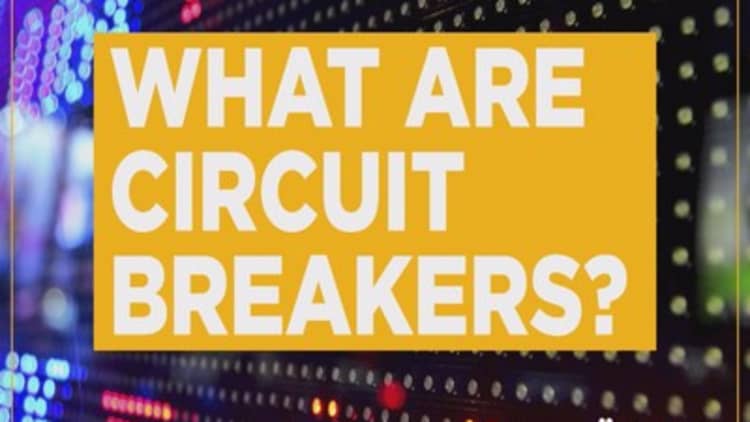
Stock exchanges attempt to ease panic selling by taking certain steps to halt trading. These moves are called market circuit breakers—or collars. Under extreme conditions that could trigger market disruptions, exchanges can invoke Rule 48 to make it easier and faster to open stocks.
When do market circuit breakers kick in?
Under the revised rules approved by the SEC in 2012, market-wide circuit breakers kick in when the drops 7 percent (Level 1), 13 percent (Level 2), and 20 percent (Level 3) from the prior day's close.
A market decline that triggers a Level 1 or Level 2 circuit breaker before 3:25 p.m. will halt market-wide trading for 15 minutes, while a similar market decline "at or after" 3:25 p.m. will not halt market-wide trading.
For Thursday, Jan. 7, the market-wide circuit breaker levels are:
Level 1 = 1,850.94
Level 2 = 1,731.52
Level 3 = 1,592.20
When were market circuit breakers first conceived?
The markets instituted circuit breakers in the wake of 1987's "Black Monday." On Oct. 19, 1987, the market plunged 508.32 points, 22.6 percent, or $500 billion lost in one day. This was the largest one-day percentage drop in history until that time.
Circuit breakers were first used in October 1989, following a major stock market drop.
Until 1997, the markets used a point drop rule—that is, looking at how many points the markets declined, rather than the percentage of the move, to trigger circuit breakers to stop trading.
What is Rule 48?
Unlike a circuit breaker that stops stock trading, the Securities and Exchange Commission's Rule 48 makes it easier and faster to open the stock markets — when there are fears that the market could open with a lot of volatility that would disrupt trading.
Where circuit breakers and Rule 48 may be related is the the rule could be used the day after a circuit breaker has been enforced.
Rule 48 speeds up the opening by suspending the requirement that stock prices be announced at the market open. Those prices have to be approved by stock market floor managers before trading actually begins. Without that approval, stock trading can begin sooner.
To invoke Rule 48, an exchange would have to determine that certain conditions exist that would cause market disruptions. Those conditions include:
- volatility during the previous day's trading session
- trading in foreign markets before the open
- substantial activity in the futures market before the open
- the volume of pre-opening indications of interest
- government announcements
Rule 48 was approved by the SEC in December of 2007.
It's been invoked twice: on Tuesday, January 22, 2008 and on Thursday, May 20, 2010. In 2008, the stock markets were subject to great volatility over fears of a global recession and in 2010, the European debt crisis caused panic buying and selling.



